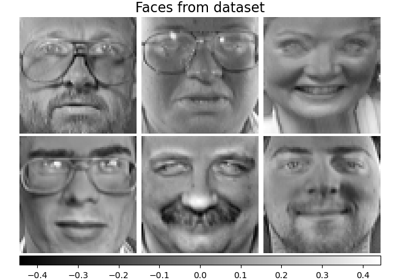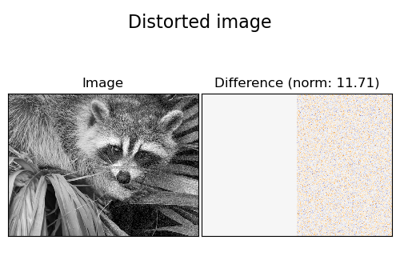MiniBatchDictionaryLearning#
- class sklearn.decomposition.MiniBatchDictionaryLearning(n_components=None, *, alpha=1, max_iter=1000, fit_algorithm='lars', n_jobs=None, batch_size=256, shuffle=True, dict_init=None, transform_algorithm='omp', transform_n_nonzero_coefs=None, transform_alpha=None, verbose=False, split_sign=False, random_state=None, positive_code=False, positive_dict=False, transform_max_iter=1000, callback=None, tol=0.001, max_no_improvement=10)[source]#
Mini-batch dictionary learning.
Finds a dictionary (a set of atoms) that performs well at sparsely encoding the fitted data.
Solves the optimization problem:
(U^*,V^*) = argmin 0.5 || X - U V ||_Fro^2 + alpha * || U ||_1,1 (U,V) with || V_k ||_2 <= 1 for all 0 <= k < n_components
||.||_Fro stands for the Frobenius norm and ||.||_1,1 stands for the entry-wise matrix norm which is the sum of the absolute values of all the entries in the matrix.
Read more in the User Guide.
- Parameters:
- n_componentsint, default=None
Number of dictionary elements to extract.
- alphafloat, default=1
Sparsity controlling parameter.
- max_iterint, default=1_000
Maximum number of iterations over the complete dataset before stopping independently of any early stopping criterion heuristics.
Added in version 1.1.
- fit_algorithm{‘lars’, ‘cd’}, default=’lars’
The algorithm used:
'lars': uses the least angle regression method to solve the lasso problem (linear_model.lars_path)'cd': uses the coordinate descent method to compute the Lasso solution (linear_model.Lasso). Lars will be faster if the estimated components are sparse.
- n_jobsint, default=None
Number of parallel jobs to run.
Nonemeans 1 unless in ajoblib.parallel_backendcontext.-1means using all processors. See Glossary for more details.- batch_sizeint, default=256
Number of samples in each mini-batch.
Changed in version 1.3: The default value of
batch_sizechanged from 3 to 256 in version 1.3.- shufflebool, default=True
Whether to shuffle the samples before forming batches.
- dict_initndarray of shape (n_components, n_features), default=None
Initial value of the dictionary for warm restart scenarios.
- transform_algorithm{‘lasso_lars’, ‘lasso_cd’, ‘lars’, ‘omp’, ‘threshold’}, default=’omp’
Algorithm used to transform the data:
'lars': uses the least angle regression method (linear_model.lars_path);'lasso_lars': uses Lars to compute the Lasso solution.'lasso_cd': uses the coordinate descent method to compute the Lasso solution (linear_model.Lasso).'lasso_lars'will be faster if the estimated components are sparse.'omp': uses orthogonal matching pursuit to estimate the sparse solution.'threshold': squashes to zero all coefficients less than alpha from the projectiondictionary * X'.
- transform_n_nonzero_coefsint, default=None
Number of nonzero coefficients to target in each column of the solution. This is only used by
algorithm='lars'andalgorithm='omp'. IfNone, thentransform_n_nonzero_coefs=int(n_features / 10).- transform_alphafloat, default=None
If
algorithm='lasso_lars'oralgorithm='lasso_cd',alphais the penalty applied to the L1 norm. Ifalgorithm='threshold',alphais the absolute value of the threshold below which coefficients will be squashed to zero. IfNone, defaults toalpha.Changed in version 1.2: When None, default value changed from 1.0 to
alpha.- verbosebool or int, default=False
To control the verbosity of the procedure.
- split_signbool, default=False
Whether to split the sparse feature vector into the concatenation of its negative part and its positive part. This can improve the performance of downstream classifiers.
- random_stateint, RandomState instance or None, default=None
Used for initializing the dictionary when
dict_initis not specified, randomly shuffling the data whenshuffleis set toTrue, and updating the dictionary. Pass an int for reproducible results across multiple function calls. See Glossary.- positive_codebool, default=False
Whether to enforce positivity when finding the code.
Added in version 0.20.
- positive_dictbool, default=False
Whether to enforce positivity when finding the dictionary.
Added in version 0.20.
- transform_max_iterint, default=1000
Maximum number of iterations to perform if
algorithm='lasso_cd'or'lasso_lars'.Added in version 0.22.
- callbackcallable, default=None
A callable that gets invoked at the end of each iteration.
Added in version 1.1.
- tolfloat, default=1e-3
Control early stopping based on the norm of the differences in the dictionary between 2 steps.
To disable early stopping based on changes in the dictionary, set
tolto 0.0.Added in version 1.1.
- max_no_improvementint, default=10
Control early stopping based on the consecutive number of mini batches that does not yield an improvement on the smoothed cost function.
To disable convergence detection based on cost function, set
max_no_improvementto None.Added in version 1.1.
- Attributes:
- components_ndarray of shape (n_components, n_features)
Components extracted from the data.
- n_features_in_int
Number of features seen during fit.
Added in version 0.24.
- feature_names_in_ndarray of shape (
n_features_in_,) Names of features seen during fit. Defined only when
Xhas feature names that are all strings.Added in version 1.0.
- n_iter_int
Number of iterations over the full dataset.
- n_steps_int
Number of mini-batches processed.
Added in version 1.1.
See also
DictionaryLearningFind a dictionary that sparsely encodes data.
MiniBatchSparsePCAMini-batch Sparse Principal Components Analysis.
SparseCoderFind a sparse representation of data from a fixed, precomputed dictionary.
SparsePCASparse Principal Components Analysis.
References
J. Mairal, F. Bach, J. Ponce, G. Sapiro, 2009: Online dictionary learning for sparse coding (https://www.di.ens.fr/~fbach/mairal_icml09.pdf)
Examples
>>> import numpy as np >>> from sklearn.datasets import make_sparse_coded_signal >>> from sklearn.decomposition import MiniBatchDictionaryLearning >>> X, dictionary, code = make_sparse_coded_signal( ... n_samples=30, n_components=15, n_features=20, n_nonzero_coefs=10, ... random_state=42) >>> dict_learner = MiniBatchDictionaryLearning( ... n_components=15, batch_size=3, transform_algorithm='lasso_lars', ... transform_alpha=0.1, max_iter=20, random_state=42) >>> X_transformed = dict_learner.fit_transform(X)
We can check the level of sparsity of
X_transformed:>>> np.mean(X_transformed == 0) > 0.5 np.True_
We can compare the average squared euclidean norm of the reconstruction error of the sparse coded signal relative to the squared euclidean norm of the original signal:
>>> X_hat = X_transformed @ dict_learner.components_ >>> np.mean(np.sum((X_hat - X) ** 2, axis=1) / np.sum(X ** 2, axis=1)) np.float64(0.052)
For a more detailed example, see Image denoising using dictionary learning
- fit(X, y=None)[source]#
Fit the model from data in X.
- Parameters:
- Xarray-like of shape (n_samples, n_features)
Training vector, where
n_samplesis the number of samples andn_featuresis the number of features.- yIgnored
Not used, present for API consistency by convention.
- Returns:
- selfobject
Returns the instance itself.
- fit_transform(X, y=None, **fit_params)[source]#
Fit to data, then transform it.
Fits transformer to
Xandywith optional parametersfit_paramsand returns a transformed version ofX.- Parameters:
- Xarray-like of shape (n_samples, n_features)
Input samples.
- yarray-like of shape (n_samples,) or (n_samples, n_outputs), default=None
Target values (None for unsupervised transformations).
- **fit_paramsdict
Additional fit parameters. Pass only if the estimator accepts additional params in its
fitmethod.
- Returns:
- X_newndarray array of shape (n_samples, n_features_new)
Transformed array.
- get_feature_names_out(input_features=None)[source]#
Get output feature names for transformation.
The feature names out will prefixed by the lowercased class name. For example, if the transformer outputs 3 features, then the feature names out are:
["class_name0", "class_name1", "class_name2"].- Parameters:
- input_featuresarray-like of str or None, default=None
Only used to validate feature names with the names seen in
fit.
- Returns:
- feature_names_outndarray of str objects
Transformed feature names.
- get_metadata_routing()[source]#
Get metadata routing of this object.
Please check User Guide on how the routing mechanism works.
- Returns:
- routingMetadataRequest
A
MetadataRequestencapsulating routing information.
- get_params(deep=True)[source]#
Get parameters for this estimator.
- Parameters:
- deepbool, default=True
If True, will return the parameters for this estimator and contained subobjects that are estimators.
- Returns:
- paramsdict
Parameter names mapped to their values.
- inverse_transform(X)[source]#
Transform data back to its original space.
- Parameters:
- Xarray-like of shape (n_samples, n_components)
Data to be transformed back. Must have the same number of components as the data used to train the model.
- Returns:
- X_originalndarray of shape (n_samples, n_features)
Transformed data.
- partial_fit(X, y=None)[source]#
Update the model using the data in X as a mini-batch.
- Parameters:
- Xarray-like of shape (n_samples, n_features)
Training vector, where
n_samplesis the number of samples andn_featuresis the number of features.- yIgnored
Not used, present for API consistency by convention.
- Returns:
- selfobject
Return the instance itself.
- set_output(*, transform=None)[source]#
Set output container.
See Introducing the set_output API for an example on how to use the API.
- Parameters:
- transform{“default”, “pandas”, “polars”}, default=None
Configure output of
transformandfit_transform."default": Default output format of a transformer"pandas": DataFrame output"polars": Polars outputNone: Transform configuration is unchanged
Added in version 1.4:
"polars"option was added.
- Returns:
- selfestimator instance
Estimator instance.
- set_params(**params)[source]#
Set the parameters of this estimator.
The method works on simple estimators as well as on nested objects (such as
Pipeline). The latter have parameters of the form<component>__<parameter>so that it’s possible to update each component of a nested object.- Parameters:
- **paramsdict
Estimator parameters.
- Returns:
- selfestimator instance
Estimator instance.
- transform(X)[source]#
Encode the data as a sparse combination of the dictionary atoms.
Coding method is determined by the object parameter
transform_algorithm.- Parameters:
- Xndarray of shape (n_samples, n_features)
Test data to be transformed, must have the same number of features as the data used to train the model.
- Returns:
- X_newndarray of shape (n_samples, n_components)
Transformed data.

